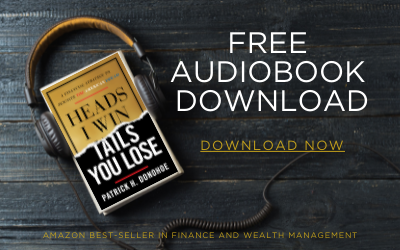As your wealth grows, so does the risk of losing more of it to taxes. Without a clear strategy, much of what you build — through investments, business income, or savings — can quietly erode through tax drag, leaving you with less to support your lifestyle, goals, and legacy.
At Paradigm Life, we view tax efficiency as an essential part of The Perpetual Wealth Strategy™. It’s not simply about choosing tax-advantaged accounts — it’s about integrating tools like Whole Life Insurance to add stability, liquidity, and long-term tax advantages to your complete wealth strategy.
Understanding Tax-Efficient Investing — Why It Matters for Long-Term Wealth?

At its core, tax-efficient investing is about building and managing wealth in ways that help you legally minimize unnecessary tax exposure — so more of what you earn and grow stays working for you.
It’s not about tax avoidance or short-term tactics. It’s about designing a wealth system that protects your cash flow and optimizes how your investments are taxed — now, as they grow, and as they are passed on to the next generation.
For many investors, taxes are one of the largest, most consistent drains on wealth. The more you accumulate, the more exposed you become to:
- Higher income tax brackets
- Investment income taxes
- Capital gains taxes
- Taxes on retirement account withdrawals
- Estate and inheritance taxes
Over time, this tax drag can quietly erode compounding and reduce the freedom and flexibility your wealth should provide — especially for high earners or those building significant business and investment portfolios.
This is why tax-efficient investing for high earners and financially established individuals is not optional — it’s essential.
And it’s why The Perpetual Wealth Strategy™ always integrates tax efficiency into a broader system of:
- Optimized cash flow
- Protection-first planning
- Smart, sustainable growth
- Purpose-driven wealth transfer
When done well, tax-efficient investing allows you to:
- Protect more of what you’ve built
- Grow wealth with greater consistency and certainty
- Enjoy more flexibility and freedom — both now and in retirement
- Pass on more to your family and legacy
What this means for you is a wealth strategy that works with you and for you — not one where unnecessary taxes quietly undermine your success.
Tax-Efficient Investing Strategies That Work
Smart tax-efficient investing is not about chasing loopholes or the latest trends — it’s about building a stable, adaptable system that helps you grow and protect wealth across all phases of life.
The most effective tax-efficient investing strategies are those that:
- Enhance cash flow
- Reduce unnecessary tax drag
- Preserve flexibility
- Protect against life’s uncertainties
- Support long-term wealth transfer
Here are several proven strategies that align with The Perpetual Wealth Strategy™ and help investors build purposeful, tax-efficient wealth:
Use Whole Life Insurance for Tax-Advantaged Growth and Liquidity
A properly structured Whole Life Insurance policy is one of the most powerful tools in a tax-efficient wealth strategy:
- Cash value grows tax-deferred.
- Funds can be accessed through policy loans, often on a tax-free basis.
- Death benefit is generally passed on tax-free to beneficiaries.
Unlike market-based investments, Whole Life offers guaranteed growth, stability, and liquidity — providing a tax-efficient foundation that complements more volatile assets.
Build a Tax-Efficient Portfolio
A tax-efficient portfolio is built intentionally — balancing asset location (which types of accounts hold which investments) and asset selection (which types of investments to prioritize).
Key considerations include:
- Using taxable accounts for long-term capital gains and tax-efficient ETFs.
- Leveraging tax-advantaged accounts (such as IRAs or 401(k)s) for income-heavy assets.
- Holding stable, liquid assets like Whole Life cash value outside of taxable markets to provide flexibility and tax advantages.
Leverage Real Estate and Depreciation
Real estate can be an extremely tax-efficient asset class when used strategically:
- Rental income can be offset by depreciation and other deductions.
- 1031 exchanges can defer capital gains taxes on property sales.
- Real estate also creates passive income, supporting cash flow and financial independence.
When paired with Whole Life liquidity, real estate investing can be both tax-efficient and more resilient — with capital available to navigate market cycles.
Prioritize Capital Gains Over Ordinary Income
Investments that generate capital gains (taxed at typically lower rates) are often more tax-efficient than those that produce ordinary income (taxed at higher rates).
Balancing your portfolio toward tax-advantaged growth — rather than taxable yield — is key to long-term efficiency.
Optimize Use of Tax-Deferred and Tax-Free Accounts
While tax-deferred retirement accounts (like traditional IRAs or 401(k)s) can reduce taxable income now, they also create future tax obligations.
Tax-free growth tools — such as Whole Life Insurance — and strategies like Roth conversions can help diversify tax treatment across your assets.
This gives you more flexibility when drawing income later — especially in retirement.
How Whole Life Insurance Supports Tax-Efficient Investing

Many investors focus solely on market accounts or retirement vehicles when thinking about tax-efficient investing — but they often overlook one of the most powerful tools: Whole Life Insurance.
When structured properly, Whole Life serves as a unique Tier 1 asset that strengthens your entire wealth strategy — offering tax advantages, liquidity, and protection in ways market-based investments cannot.
Here’s how Whole Life supports tax-efficient investing:
Tax-Deferred Growth of Cash Value
The cash value inside a Whole Life policy grows on a tax-deferred basis — meaning you won’t pay taxes on annual growth. This allows the value to compound over time without tax drag, creating a stable source of wealth you can access when needed.
Tax-Free Access Through Policy Loans
One of the greatest advantages of Whole Life is the ability to access funds via policy loans, typically without triggering taxable events. Unlike retirement accounts with age restrictions or penalties, policy loans provide flexible liquidity — allowing you to fund opportunities or supplement income without taxable withdrawals.
Tax-Free Death Benefit
The policy’s death benefit is generally passed on to beneficiaries income tax-free. This provides a built-in wealth transfer tool that supports multi-generational tax efficiency — helping your heirs receive more of what you’ve built.
Stability and Liquidity That Protect Tax-Sensitive Assets
Whole Life serves as a non-correlated, liquid asset — meaning it doesn’t fluctuate with the market. This stability allows you to:
- Avoid selling tax-sensitive assets during market downturns.
- Manage tax timing more strategically.
- Maintain cash flow and flexibility in all market conditions.
When integrated with your broader investing strategy, Whole Life allows you to make more tax-smart decisions — whether that means deferring capital gains, controlling taxable income, or optimizing withdrawal timing in retirement.
How to Build a Tax-Efficient Wealth System

- Build on a Foundation of Cash Flow and Protection
Start with a stable foundation. Whole Life Insurance provides liquidity and protection, allowing you to manage taxes proactively — not reactively. Strong cash flow gives you the flexibility to make tax-smart decisions without disrupting your lifestyle.
- Balance Tax Treatment Across Assets
Smart tax-efficient investing isn’t just about what you invest in — it’s about where you hold those investments. Balance tax-free, tax-deferred, and taxable accounts so you have multiple levers to manage taxes at different life stages.
- Leverage Whole Life for Liquidity and Flexibility
Whole Life cash value gives you tax-advantaged liquidity. By using policy loans strategically, you can supplement income, fund opportunities, or avoid selling taxable assets in down markets — helping you stay tax-efficient even in volatile times.
- Manage Income Timing to Reduce Tax Drag
Tax efficiency improves when you can control when income is recognized. Sequence withdrawals, tap Whole Life loans when needed, and use passive income sources intentionally. The goal is to manage your taxable income in a way that preserves flexibility.
- Plan for Tax-Efficient Wealth Transfer
A true tax-efficient wealth system looks beyond your lifetime. Whole Life death benefits provide tax-free wealth transfer and liquidity for heirs. Trusts and other legacy planning tools can further enhance tax efficiency across generations.
Common Tax Pitfalls That Erode Wealth

Even the most disciplined investors can lose ground if they don’t approach taxes strategically. Without a clear system, it’s easy for tax inefficiencies to quietly erode wealth year after year — reducing both cash flow and long-term outcomes.
Here are several common tax pitfalls that a purpose-driven strategy helps you avoid:
- Chasing Yield Without Tax Awareness
Investments that generate high ordinary income may look attractive — but they can also push you into higher tax brackets or trigger unexpected tax consequences. Tax-efficient investing focuses not just on return, but on after-tax return — what you actually keep.
- Over-Reliance on Tax-Deferred Accounts
While tax-deferred retirement accounts (like 401(k)s and traditional IRAs) can reduce taxes today, they also create future tax obligations — often when your portfolio is largest. Without balance, this can lead to taxable income “traps” later in life. Integrating tax-free and tax-efficient assets — such as Whole Life cash value — helps you manage this risk.
- Forced Taxable Withdrawals
Without adequate liquidity, many investors are forced to sell taxable assets during market downturns — locking in gains at an inopportune time and triggering taxes. Maintaining Whole Life liquidity gives you access to funds without forced taxable events, protecting both portfolio value and tax positioning.
- Poor Withdrawal Sequencing in Retirement
Taking income in the wrong order — or from the wrong accounts — can lead to unnecessarily high tax bills in retirement. A well-structured plan sequences taxable, tax-deferred, and tax-free withdrawals to minimize taxes across decades, not just in a single year.
FAQs About Tax-Efficient Investing
Which investments are most tax efficient?
Investments that generate capital gains (taxed at lower rates), tax-free income (like Whole Life cash value loans), and assets with tax deferral (such as real estate with depreciation or tax-advantaged accounts) tend to be the most tax efficient when used as part of a coordinated wealth strategy.
Is it better to invest before or after-tax?
Both have a place in a tax-efficient system. Tax-deferred accounts (before-tax) reduce taxable income now but create future tax obligations. After-tax assets like Whole Life and Roth accounts offer tax-free access and flexibility later — providing balance across life phases.
How do I build a tax-efficient retirement income plan?
A tax-efficient retirement income plan balances income from tax-free, tax-deferred, and taxable sources — allowing you to manage tax brackets and preserve flexibility. Whole Life cash value plays a key role here, providing tax-free liquidity to support spending without triggering taxable withdrawals.
Bringing It All Together: Build Your Tax-Efficient Wealth System
Tax-efficient investing is about more than reducing this year’s tax bill — it’s about building a financial system that protects what you’ve built, grows it with greater certainty, and gives you more freedom to enjoy your wealth now and in the future.
When you integrate Whole Life Insurance with purpose-driven tax strategies, you create a stable foundation for smarter investing — one that supports cash flow, enhances flexibility, and preserves wealth across generations.If you’re ready to design a tax-efficient wealth system that aligns with your goals and values, schedule a conversation with a Paradigm Life Wealth Strategist. Together, we’ll help you build a strategy that protects more, grows more, and helps you enjoy more of what life has to offer.







